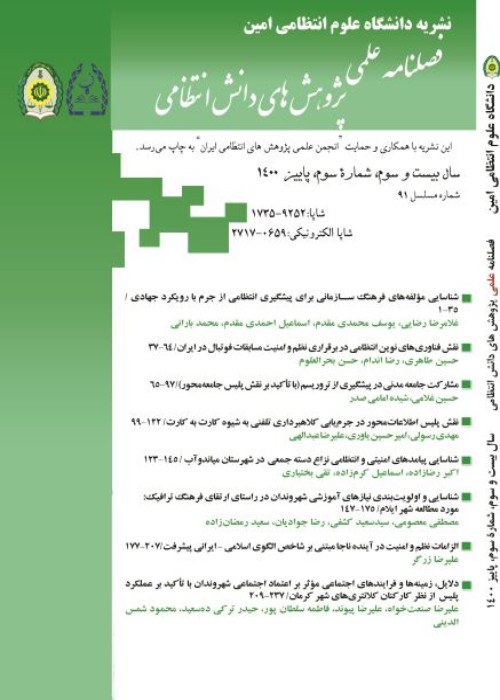Designing the Evaluation Model of Education System in Police University
Author(s):
Abstract:
Background and
Purpose
the present study has been carried out aiming at designing an education system evaluation model in Police University, determining the indicators and criteria for each of the education evaluation dimensions, determining the indicators and criteria for empowerment evaluation, the results and consequences of the system, and also determining the weight, importance, and the relationship of each dimension, indicators, and the evaluation criteria of this system.Methodology
this study is of an implicational type and the qualitative and quantitative methods are also employed in this research. In order to collect qualitative data, we got benefit of the viewpoints of 21 Police University administrators and faculty members who are expert in the field of police education and training (ideological-political, counterintelligence-security, military-disciplinary, physical fitness and psychological studies). In order to collect quantitative data, 151 professors were selected out of 249 professors and they answered the questionnaire. The validity of this model was obtained using the experts’ ideas and the reliability was obtained using Cronbach Alpha Coefficient.Findings and Results
the results showed that the model has a satisfactory validity and reliability. The obtained model is formed of three dimensions of empowerment instruments, results, and consequences and also two internal and external dimensions and each of these dimensions is composed of some factors, criteria, and indicators. According to the 900-point model, each of the dimensions of empowerment instruments, results, and consequences have 400, 200, and 300 points, respectively. In addition, the internal dimension of empowerment instruments has devoted 60% (240 points) and the external dimension of empowerment instruments has devoted 40% (160 points) of all the points related to the empowerment instruments to themselves. Among the four factors related to the internal dimension of empowerment instruments (development and learning, capacity and power, internal process and budget), most of the points was for the factor of development and learning containing 89 points. The external dimension of empowerment instruments is also composed of two factors that 83 points of that are devoted to rules and regulations and 77 points of that are devoted to policies and strategies. 104 out of 200 points related to the dimension of results are devoted to the training factor and 96 points are devoted to education. The consequences dimension is composed of four factors. The 96 points out of 300 points of consequences are devoted to internal stakeholders’ satisfaction, 84 points are devoted to external stakeholders’ satisfaction, 57 points are devoted to the inside excel and 63 points are devoted to outside excel. At the end, according to the obtained results, it can be said that the formulated model has a satisfactory validity and reliability and it can be used for evaluating educational and training system in Police University.Keywords:
Language:
Persian
Published:
Danesh-e-Entezami, Volume:15 Issue: 4, 2014
Pages:
107 to 140
magiran.com/p1433100
دانلود و مطالعه متن این مقاله با یکی از روشهای زیر امکان پذیر است:
اشتراک شخصی
با عضویت و پرداخت آنلاین حق اشتراک یکساله به مبلغ 1,390,000ريال میتوانید 70 عنوان مطلب دانلود کنید!
اشتراک سازمانی
به کتابخانه دانشگاه یا محل کار خود پیشنهاد کنید تا اشتراک سازمانی این پایگاه را برای دسترسی نامحدود همه کاربران به متن مطالب تهیه نمایند!
توجه!
- حق عضویت دریافتی صرف حمایت از نشریات عضو و نگهداری، تکمیل و توسعه مگیران میشود.
- پرداخت حق اشتراک و دانلود مقالات اجازه بازنشر آن در سایر رسانههای چاپی و دیجیتال را به کاربر نمیدهد.
In order to view content subscription is required
Personal subscription
Subscribe magiran.com for 70 € euros via PayPal and download 70 articles during a year.
Organization subscription
Please contact us to subscribe your university or library for unlimited access!


